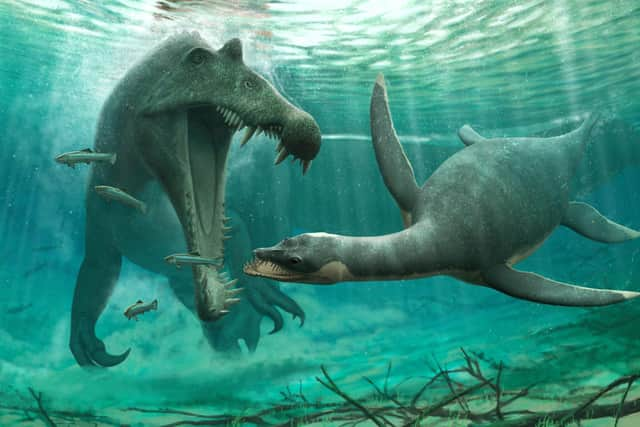Existence of Loch Ness Monster 'plausible' after discovery of fossils in North Africa
Fossils of small plesiosaurs, which typically had small heads, long necks and four long flippers, have been found in a 100-million-year-old river that lies under Morocco’s Sahara Desert.
The discovery suggests some species of plesiosaur, traditionally thought to be sea creatures, may have lived in freshwater.
Advertisement
Hide AdAdvertisement
Hide AdPlesiosaurs, first found by fossil hunter Mary Anning in 1823, have inspired a stream of reconstructions of the Loch Ness Monster. But unlike Nessie, plesiosaurs were marine animals – or widely thought to be.
The findings in Morocco raise the possibility that freshwater Loch Ness may well have been a suitable habitat for such a creature – albeit millions of years ago.
A statement from Bath University, whose scientists led the research in Morocco, said the existence of the Loch Ness Monster, on one level, was “plausible”.
It added: “Plesiosaurs weren’t confined to the seas, they did inhabit freshwater. But the fossil record also suggests that after almost a hundred and fifty million years, the last plesiosaurs finally died out at the same time as the dinosaurs, 66 million years ago.”
Reports of a strange creature living in Loch Ness date back to ancient times. Notably, a flippered beast is depicted in Pictish carvings, with the first written account of the animal appearing in a biography of St Columba from 565AD.


The modern legend of Loch Ness dates from April 1933, when a new road along the shore offered the first clear views of the loch from the northern side.
A local couple driving home spotted “an enormous animal rolling and plunging on the surface”, with their account appearing in The Inverness Courier, with the word “monster” used in the copy. The Nessie phenomenon was born.
Serious research into the Loch Ness Monster still continues, with researchers from New Zealand last year concluding that Nessie may have been a giant eel, based on the DNA of the loch.
Advertisement
Hide AdAdvertisement
Hide AdMeanwhile, more than 1,140 sightings have been recorded by the Official Loch Ness Sightings Register, including four this year.
The recent findings from Morocco has challenged traditional thinking on which dinosaur-age creatures lived where.
Dr Nick Longrich, from the University of Bath’s Milner Centre for Evolution, said: “We don’t really know why the plesiosaurs are in freshwater.
“It’s a bit controversial, but who’s to say that because we paleontologists have always called them ‘marine reptiles’, they had to live in the sea? Lots of marine lineages invaded freshwater.”
Dr Longrich worked with counterparts from the University of Portsmouth and Université Hassan II in Morocco on the fossil discovery from the Cretaceous-aged river in Africa, which dates back 100 million years.
The fossils include bones and teeth from three-metre long adults and an arm bone from a 1.5m-long baby. They hint these creatures routinely lived and fed in freshwater, alongside frogs, crocodiles, turtles, fish and the huge aquatic dinosaur Spinosaurus.
Scientists now believe the plesiosaur was able to tolerate both fresh and salt water, like some whales, such as the beluga whale.
Comments
Want to join the conversation? Please or to comment on this article.